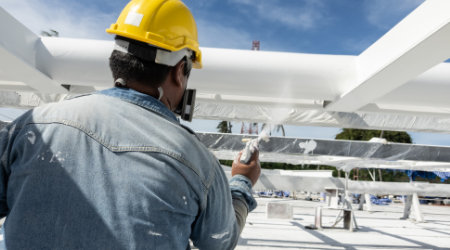Comparing Two Popular Fire-Resistant Coatings
Both intumescent and cementitious coatings have pros and cons. Maintenance departments can use this guide to choose the best option.
When it comes to fire-resistant coatings, two of the most popular options are intumescent paint and cementitious coatings.
Each coating has its own advantages — intumescent coatings are very effective, but also relatively expensive, while cementitious coatings are easier on your budget, but come with some specific shortcomings, which we’ll touch on below.
Let’s look at each type of coating in detail, run down the specific pros and cons of each one, and touch on the best applications for each coating.
What are intumescent and cementitious coatings?
Intumescent paint expands in the presence of fire to protect and insulate its substrate.
It works like this: an intumescent coating is made up of a chemical mixture that’s suspended in a binder. When it’s exposed to the heat from a fire, the binder melts, and a chemical reaction begins. This chemical reaction produces foam, and the formerly thin intumescent coating begins to radically expand, typically becoming 25-50 times thicker.
This chemical foam insulates the substrate from fire damage; applied to steel, it can prevent that steel from buckling even in intense heat.
Cementitious coatings are more straightforward. These are essentially coatings that are mixed with lightweight cement. Conventional concrete is tremendously fire-resistant — and cheap; but it’s impractical as a general fire resistance measure because of its weight, which requires heavy steel structural support.
Cementitious coatings, on the other hand, give you all the fire resistance of concrete, while also being lightweight. They’re also quite inexpensive, especially compared to intumescent coatings.
So what’s the catch? Well, like conventional concrete, they’re quite labor intensive to apply. They require extensive surface prep, and then several coats.
And that’s not all; when a cementitious coating dries, it separates, ever so slightly, from its substrate. If moisture builds up in that space, as it often does in moist environments, it can corrode the very surface that the cementitious coating is supposed to be protecting.
Pros and Cons
Let’s survey the advantages and disadvantages of each coating.
Intumescent Pros
- Very aesthetically pleasing — looks like conventional paint
- Great adhesion to substrate
- Excellent all-around performance
Intumescent Cons
- Can be quite expensive — up to $4-12 per square foot
- Usually requires surface prep, plus a primer
- May require a topcoat if applied to steel
Cementitious Pros
- Inexpensive
- Much lighter than conventional concrete
- Resistant to chlorides, acid gases, and chemicals
Cementitious Cons
- Tends to separate from the substrate as it dries
- Often cracks while cooling after a fire
- Not aesthetically pleasing
When you look at what each coating has to offer, it’s obvious there’s no one-size-fits-all solution here; the best coating for you is going to depend on your unique circumstances. That being said, let’s touch on the ideal application for each coating.
Intumescent coatings excel in settings where they’ll be highly visible, as intumescent paint looks as appealing as a fine conventional paint, or even a top-grade epoxy if a topcoat is applied. They’re also ideal in high moisture environments, since they adhere closely to the substrate, locking out moisture.
They’re also great for mild or climate-controlled environments. However, local factors at the time of application like humidity, temperature, and dew point are a huge factor in how well (or how poorly) the coating adheres to the substrate.
Cementitious coatings are ideal for dry environments, where moisture accumulation isn’t a concern. They’re also great for surfaces that won’t be regularly observed, like underwater structures, roof structures, or highway structures.
Note that facility managers need to consider the NFPA and IBC guidelines, as well as local guidelines, whenever choosing a structural fireproof coating.
While both coatings offer very effective fire resistance, intumescent paint is simply more versatile, nicer to look at, and more advanced.
That being said, in settings where minimal fireproofing is needed, budgets are limited, or aesthetics aren’t a concern, cementitious coatings are a perfectly acceptable alternative.
Just keep in mind that, regardless of your choice, facility managers need to follow IBC and NFPA standards when determining their fire protection. Just to be on the safe side, it’s probably best to consult with an expert coatings professional to make sure you’re in full compliance.
Tommy O’Shaughnessy is the owner of CDN Paint, the online platform that connects owners, facility managers and engineers with top-rated coatings professionals.
Related Topics:












